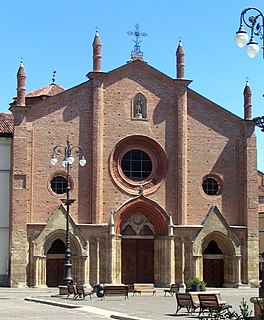Saint Gavinus is a Christian saint who is greatly celebrated in Sardinia, Italy, as one of the Martyrs of Torres, along with his companions SS Protus, a bishop, and Januarius, a deacon.

Doire was a department of the French Consulate and of the First French Empire in present-day Italy. It was named after the river Dora Baltea. It was formed in 1802, when the Subalpine Republic was directly annexed to France. Its capital was Ivrea.

The Theban Legion figures in Christian hagiography as a Roman legion from Egypt—"six thousand six hundred and sixty-six men"—who converted en masse to Christianity and were martyred together in 286, according to the hagiographies of Saint Maurice, the chief among the Legion's saints. Their feast day is held on September 22.

Victor the Moor was a native of Mauretania and a Christian martyr, according to tradition, and is venerated as a saint.
Saint Gabinus is the title given to two personages.
Saint Proculus (Proclus) of Pozzuoli was martyred around 305 AD, according to Christian tradition, at the same time as Saint Januarius.

Saint Juvenal is venerated as the first Bishop of Narni in Umbria. Historical details regarding Juvenal's life are limited. A biography of Juvenal of little historical value, written after the seventh century, states that Juvenal was born in Africa, was ordained by Pope Damasus I, was the first bishop of Narni, and was buried in the Porta Superiore on the Via Flaminia on August 7, though his feast day was celebrated on May 3. This Vita does not call him a martyr but calls him a confessor. The martyrologies of Florus of Lyon and Ado describe Juvenal as a bishop and confessor rather than as a martyr.

The Basilica of Our Lady Help of Christians is a church in Turin, northern Italy. Originally part of the home for poor boys founded by John Bosco, it now contains the remains of Don Bosco, and 6,000 relics of other saints.

Secundus of Asti is venerated as a martyr and saint. His feast day is generally celebrated on March 29. Until the 15th century it was celebrated at Asti on March 30, but it is now celebrated there on the first Tuesday in May. He was a historical figure who was beheaded at Asti under Hadrian. He is said to have been a patrician of Asti and a subaltern officer in the imperial army. It is known that a church was dedicated to him in the area as early as the 9th century.

Saints Victor and Corona are two Christian martyrs. Victor was a Roman soldier who was tortured and killed; Corona was killed for comforting him. Corona is invoked as a patron of causes involving money; she was not historically associated with pandemics or disease, but has been invoked against the coronavirus pandemic.

The Basilica of Saints John and Paul on the Caelian Hill is an ancient basilica church in Rome, located on the Caelian Hill. It was originally built in 398.
Saints Felinus and Gratian(us) are venerated as martyrs by the Catholic and Eastern Orthodox churches. They are patron saints of Arona, near Milan, where their relics were enshrined.

Saint Sossius or Sosius was Deacon of Misenum, an important naval base of the Roman Empire in the Bay of Naples. He was martyred along with Saint Januarius at Pozzuoli during the Diocletian Persecutions. His feast day is September 23, the date, three days after his death, on which his corpse was translated to Misenum.

Saint Chiaffredo is venerated as the patron saint of Saluzzo, Italy. Tradition considers him a member of the Theban Legion, but instead of being martyred with this legion at Agaunum, he escaped to Piedmont and was martyred there.

Eleutherius (or Eleut erus or Eleftherios; sometimes called Liberalis or Liberator, the former transliterations and the latter translations of his and his mother Antia are venerated as Christian saints and martyrs in Albania.
Saint Tegulus is venerated as a member of the legendary Theban Legion, whose members were led by Saint Maurice in the 3rd century. The center of Tegulus' cult is at Ivrea. Veneration for Saint Tegulus actually arose at the end of the 10th century, when during the episcopate of Blessed Warmondus (Varmondo), the saint's relics were discovered in a sepulcher situated a short distance away from Ivrea. The relics were solemnly translated to the cathedral of Ivrea within the city walls, and placed in the chapel of San Giacomo. The relics were later translated, with those of Saint Bessus, to the chapel of Santissimo Sacramento.
Saint Bessus, sometimes Besse, is venerated as a member of the legendary Theban Legion, whose members were led by Saint Maurice and were martyred for their Christian faith in the 3rd century. Except for St. Maurice's cult, veneration for Bessus enjoyed a wider popularity than those associated with other saints of the Theban Legion and remains popular today. According to tradition, Constantius survived the decimation of his legion and fled to valleys of Aosta and Cogne. He then dedicated himself to converting the people in this area to Christianity.

Saint Vigilius of Trent is venerated as the patron saint and bishop of Trent. He should not be confused with the pope of the same name.
Gezo of Turin was an Italian bishop. He was bishop of Turin from 1000 until his death in 1011.












